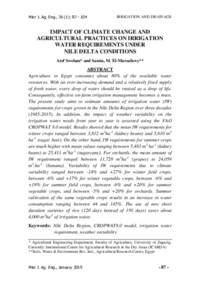Impact of climate change and agricultural practices on irrigation water requirements under Nile delta conditions

Authors:
Agriculture in Egypt consumes about 80% of the available water resources. With an ever-increasing demand and a relatively fixed supply of fresh water, every drop of water should be treated as a drop of life. Consequently, effective on-farm irrigation management becomes a must. The present study aims to estimate amounts of irrigation water (IW) requirements for crops grown in the Nile Delta Region over three decades (1985-2015). In addition, the impact of weather variability on the irrigation water needs from year to year is assessed using the FAO CROPWAT 8.0 model. Results showed that the mean IW requirements for winter crops ranged between 3,812 m3ha-1 (kidney beans) and 5,610 m3 ha-1 (sugar beet). On the other hand, IW requirements for summer crops are much higher with mean values ranging between 5,483 m3 ha-1 (kidney beans) to 25,411 m3ha-1 (sugarcane). For orchards, the mean amount of IW requirement ranged between 11,728 m3ha-1 (grapes) to 24,059 m3.ha-1 (banana). Variability of IW requirements due to climate variability ranged between -14% and +27% for winter field crops, between -6% and +17% for winter vegetable crops, between -6% and +19% for summer field crops, between -6% and +20% for summer vegetable crops, and between -5% and +20% for orchards. Summer cultivation of the same vegetable crops results in an increase in water consumption ranging between 44 and 145%. The use of new short duration varieties of rice (120 days instead of 150 days) saves about 4,000 m3ha-1 of irrigation water.
